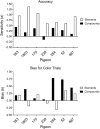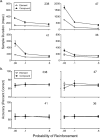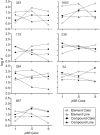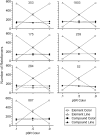Effects of reinforcer probability on attending to element and compound sample stimuli
- PMID: 40384168
- PMCID: PMC12209040
- DOI: 10.1002/jeab.70023
Effects of reinforcer probability on attending to element and compound sample stimuli
Abstract
Previous research has shown that divided-attention performance is sensitive to variations in relative reinforcement in a manner consistent with the generalized matching law. Two experiments with pigeons were designed to better understand the effects of different reinforcement conditions on divided-attention performance. Experiment 1 asked whether separate experience with different relative reinforcement probabilities for elements alone would produce changes in performance during nondifferentially reinforced divided-attention trials with compound samples consisting of those elements. The results suggest that accuracy following compound sample trials varied as a function of relative reinforcement experienced in element trials in a manner consistent with the matching law. Experiment 2 used an adjusting-sample-duration procedure to maintain constant accuracy on element and divided-attention trials and varied the probability of reinforcement across conditions. The sample durations that were required to maintain constant accuracy increased as reinforcement probability decreased even though that longer sample durations were required to maintain accuracy for compound-sample trials than for element-sample trials (the element-superiority effect). Overall, the present results are consistent with the notion that increased attention is allocated to stimuli that are associated with more reinforcement.
Keywords: DMTS; divided attention; matching law; pigeon; probability; reinforcement.
© 2025 The Author(s). Journal of the Experimental Analysis of Behavior published by Wiley Periodicals LLC on behalf of Society for the Experimental Analysis of Behavior.
Conflict of interest statement
The authors have no conflicts of interest to declare.
Figures






Similar articles
-
Intravenous magnesium sulphate and sotalol for prevention of atrial fibrillation after coronary artery bypass surgery: a systematic review and economic evaluation.Health Technol Assess. 2008 Jun;12(28):iii-iv, ix-95. doi: 10.3310/hta12280. Health Technol Assess. 2008. PMID: 18547499
-
Discounting of probabilistic food reinforcement by pigeons.J Exp Anal Behav. 2025 Jul;124(1):e70042. doi: 10.1002/jeab.70042. J Exp Anal Behav. 2025. PMID: 40662635
-
Systematic review and economic analysis of the comparative effectiveness of different inhaled corticosteroids and their usage with long-acting beta2 agonists for the treatment of chronic asthma in adults and children aged 12 years and over.Health Technol Assess. 2008 May;12(19):iii-iv, 1-360. doi: 10.3310/hta12190. Health Technol Assess. 2008. PMID: 18485271
-
A rapid and systematic review of the clinical effectiveness and cost-effectiveness of paclitaxel, docetaxel, gemcitabine and vinorelbine in non-small-cell lung cancer.Health Technol Assess. 2001;5(32):1-195. doi: 10.3310/hta5320. Health Technol Assess. 2001. PMID: 12065068
-
The effectiveness and cost-effectiveness of carmustine implants and temozolomide for the treatment of newly diagnosed high-grade glioma: a systematic review and economic evaluation.Health Technol Assess. 2007 Nov;11(45):iii-iv, ix-221. doi: 10.3310/hta11450. Health Technol Assess. 2007. PMID: 17999840
References
MeSH terms
Grants and funding
LinkOut - more resources
Full Text Sources

